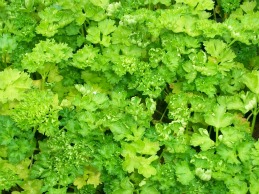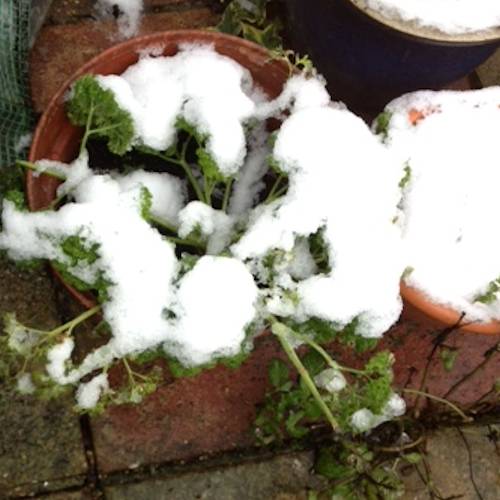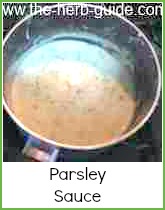- The Herb Guide Home
- Growing Herbs
- Growing Parsley
Growing Parsley
As an Amazon Associate I earn from qualifying purchases

Growing parsley is considered to be difficult, but if you bear the following in mind, you will see it isn't.
Parsley is a biennial plant - that means that it is sown one year to flower the next and then die.
Most biennial plants have long germination periods, because they don't need to reach their full potential (flowering) until their second year.

You can try a sample lesson to help you decide if the Herbal Academy of New England is the right choice for you - follow the link below.
Of course, the parts of parsley we use are the leaves - not the flowers, so that leads to our unreasonable expectations.
Parsley seed takes 5 to 8 weeks to germinate - as do most biennial seeds - but because we treat it as a herb and use its leaves, not a flower, we think it's taking too long!
Having said all that, parsley leaves are best in the first year of growth - they are crisper and fresher - a german poet once said that if we took all the good smell of plants and soil and turned it into one plant, that plant would be parsley.
How I agree - there is nothing so aromatically 'summer' as the smell of freshly cut parsley.
So - bear in mind, you're being unreasonable :-) to expect the parsley seeds to germinate as quickly as others and follow these instructions.
Growing Parsley Outdoors
Parsley prefers a heavy soil - too light, and the plants are 'leggy' so if your soil is sandy, then add some clay, loam or manure to the planting area.
The perfect aspect for growing parsley is partial shade - too much sun will damage the oils in the leaves - they will shrivel up in the sun and be too damaged even to claim you've 'dried' the parsley!
Make sure the soil is warm - spring onwards - and sow the seeds in drills - some people add radish or lettuce to the seed to act as a 'marker' then use them at half their size - very tender and a way of getting a double crop from one area.
Keep the drill moist - growing parsley needs nurturing during its long germination, so use a fine spray for your watering in order to not disturb the seeds as they germinate.
Thin the seedlings out to one every 8 inches or so and then allow them to grow on.
One tip is to pour hot water over the drill prior to planting - then the seeds will go straight into warm soil - it's reputed that parsley goes to the devil and back seven times before putting in an appearance - I don't believe that...
If it is wet when you are doing your 'thinning' then it is possible to re-plant your seedlings elsewhere. Give some pots to friends - they'll think you're a real 'Earth Mother' - sell them or give them to the bring and buy at school or church.
It is possible to sow parsley three times a year to get a continuous supply - late winter/early spring, late spring and again in summer - that way you'll have parsley all year round.
Protect the plants in winter by either moving them into a cold frame or covering them with an open frame and some mats, bubble wrap or something similar.
The parsley will self germinate (as do most biennials) from the second year onwards - allow a couple of plants to flower and they will seed - take great care of these seedling, by watering and keeping the area weed free.
The parsley leaves are more flavoured the first year of growth - the second year, the plants are concentrating on flowering to provide seeds - nip out the flower buds of the plants that you are not going to allow to flower to provide seed.
The seeds are not for culinary use - they contain concentrated oils, the use of which are beyond the scope of this guide.
Cut the leaves as often as you like during the growing season.
Don't let them flower in the first year and towards autumn, remove all the leaves from the first two sowings - maybe to freeze? - and then the plants will sprout again the following year - just leave the plants that you want to overwinter.

Growing Parsley for Winter Use
The late summer (July in the northern hemisphere) sowing should provide winter growing parsley for you - but it may be that you either want the plants nearer to the house or even indoors.
You could sow your final seeds for the year into a parsley pot - that's a small terracotta urn shaped pot with a few planting pockets in the side and one in the top.
That way, you can bring the plants nearer to the house - but
the pot will need some protection from frosts. Frost shatters the roots
- there is water in the root and when it freezes, it bursts the cells -
as you know, water expands when it's frozen - and the cells that
contain the water may expand and burst.
Alternatively, you can bring the plants indoors - from your late summer sowing, select a couple of smaller plants and pot them up.
They don't like a lot of heat - they are hardy biennials and not really suited to centrally heated houses - if you have an unheated porch, then that is the ideal place to keep your plants.
You can of course freeze parsley and you will find instructions for that within this site - but I prefer to have my plants fresh.
Bear in mind as well, that you may not use parsley as much through the winter as you did in the summer and just have a couple of plants indoors.
Having said all that, the above photo is my pot of parsley covered in snow - I knocked the snow off and the parsley was perfectly healthy and edible. It is quite a hardy plant.
Growing Parsley - Rescue Remedy
If you are lucky enough to move into a house with an established herb
garden and you identify growing parsley, then for the first year, cut
the leaves as you want - any plants that are already flowering will self
seed for the next year's use.
Remove any really straggly plants and give some extra tender loving care to the ones that are left.
If the plants are really leggy, then it may be that the soil is wrong for them.
Check that it is not too light and sandy - if it is, then remove the plants with a good root ball and grow them on in pots for this year - treat the soil to either some good loam or manure and then you can either start again with fresh seed or replant the already growing parsley plants out of their temporary home.
Keep the area weed free and then you will be able to identify which are new parsley seedlings and nurture them for culinary use.
It is perfectly possible to just have one sowing of parsley and with care, keep your parsley bed going with self seeded plants for many years.
You may prefer to treat growing parsley as an annual and just sow a row every year.
I may receive a commission if you purchase something mentioned in this post. See more details here This will not affect the amount you pay.




